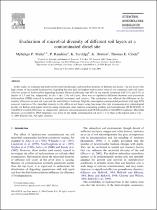 ResearchSpace
ResearchSpace
Evaluation of microbial diversity of different soil layers at a contaminated diesel site
JavaScript is disabled for your browser. Some features of this site may not work without it.
- ResearchSpace
- →
- Research Publications/Outputs
- →
- Journal Articles
- →
- View Item
| dc.contributor.author |
Maila, MP

|
en_US |
| dc.contributor.author |
Randima, P

|
en_US |
| dc.contributor.author |
Surridge, K

|
en_US |
| dc.contributor.author |
Dronen, K

|
en_US |
| dc.contributor.author |
Cloete, TE

|
en_US |
| dc.date.accessioned | 2007-02-07T13:24:55Z | en_US |
| dc.date.accessioned | 2007-06-07T10:06:33Z | |
| dc.date.available | 2007-02-07T13:24:55Z | en_US |
| dc.date.available | 2007-06-07T10:06:33Z | |
| dc.date.issued | 2005-01 | en_US |
| dc.identifier.citation | Maila, MP, et al. 2005. Evaluation of microbial diversity of different soil layers at a contaminated diesel site. International Bio-deterioration & Biodegradation, vol. 55(1), pp 1-39 | en_US |
| dc.identifier.issn | 0964-8305 | en_US |
| dc.identifier.uri | http://hdl.handle.net/10204/1582 | en_US |
| dc.identifier.uri | http://hdl.handle.net/10204/1582 | |
| dc.description.abstract | In this study, the hydrocarbon removal efficiency and microbial diversity of different soil layers is evaluated. The soil layers with high counts of recoverable hydrocarbon degrading bacteria had the highest hydrocarbon removal rate compared with soil layers with low counts of hydrocarbon degrading bacteria. Removal efficiency was 48% in the topsoil, compared with 31% and 11% at depths of 1.5 and 1m, respectively. In the 1 and 1.5m soil layers, there was no significant difference between total petroleum hydrocarbon (TPH) removal in nutrient amended treatments and controls. The respiration rate reflected the difference in the number of bacteria in each soil layer and the availability of nutrients. High O2 consumption corresponded positively with high TPH removal. Analysis of the microbial diversity in the different soil layers using functional diversity (community-level physiological profile, via Biolog) and genetic diversity using polymerase chain reaction-denaturing gradient gel electrophoresis (PCR-DGGE) of 16S rDNA revealed differences in, respectively, substrate utilization patterns and DGGE profiles of 16S rDNA fragments. Microbial diversity as revealed by DNA fragments was lower in the highly contaminated soil layer (1.5 m) than in the topsoil and at 1m. | en_US |
| dc.format.extent | 482290 bytes | en_US |
| dc.format.mimetype | application/pdf | en_US |
| dc.language.iso | en | en_US |
| dc.publisher | Elsevier Science Ltd | en_US |
| dc.rights | Copyright: 2004 Elsevier Science Ltd | en_US |
| dc.subject | Hydrocarbon contamination | en_US |
| dc.subject | Biodegration | en_US |
| dc.subject | Microbiological analysis | en_US |
| dc.subject | Biotechnology | en_US |
| dc.subject | Diesel contamination | en_US |
| dc.title | Evaluation of microbial diversity of different soil layers at a contaminated diesel site | en_US |
| dc.type | Article | en_US |
| dc.identifier.apacitation | Maila, M., Randima, P., Surridge, K., Dronen, K., & Cloete, T. (2005). Evaluation of microbial diversity of different soil layers at a contaminated diesel site. http://hdl.handle.net/10204/1582 | en_ZA |
| dc.identifier.chicagocitation | Maila, MP, P Randima, K Surridge, K Dronen, and TE Cloete "Evaluation of microbial diversity of different soil layers at a contaminated diesel site." (2005) http://hdl.handle.net/10204/1582 | en_ZA |
| dc.identifier.vancouvercitation | Maila M, Randima P, Surridge K, Dronen K, Cloete T. Evaluation of microbial diversity of different soil layers at a contaminated diesel site. 2005; http://hdl.handle.net/10204/1582. | en_ZA |
| dc.identifier.ris | TY - Article AU - Maila, MP AU - Randima, P AU - Surridge, K AU - Dronen, K AU - Cloete, TE AB - In this study, the hydrocarbon removal efficiency and microbial diversity of different soil layers is evaluated. The soil layers with high counts of recoverable hydrocarbon degrading bacteria had the highest hydrocarbon removal rate compared with soil layers with low counts of hydrocarbon degrading bacteria. Removal efficiency was 48% in the topsoil, compared with 31% and 11% at depths of 1.5 and 1m, respectively. In the 1 and 1.5m soil layers, there was no significant difference between total petroleum hydrocarbon (TPH) removal in nutrient amended treatments and controls. The respiration rate reflected the difference in the number of bacteria in each soil layer and the availability of nutrients. High O2 consumption corresponded positively with high TPH removal. Analysis of the microbial diversity in the different soil layers using functional diversity (community-level physiological profile, via Biolog) and genetic diversity using polymerase chain reaction-denaturing gradient gel electrophoresis (PCR-DGGE) of 16S rDNA revealed differences in, respectively, substrate utilization patterns and DGGE profiles of 16S rDNA fragments. Microbial diversity as revealed by DNA fragments was lower in the highly contaminated soil layer (1.5 m) than in the topsoil and at 1m. DA - 2005-01 DB - ResearchSpace DP - CSIR KW - Hydrocarbon contamination KW - Biodegration KW - Microbiological analysis KW - Biotechnology KW - Diesel contamination LK - https://researchspace.csir.co.za PY - 2005 SM - 0964-8305 T1 - Evaluation of microbial diversity of different soil layers at a contaminated diesel site TI - Evaluation of microbial diversity of different soil layers at a contaminated diesel site UR - http://hdl.handle.net/10204/1582 ER - | en_ZA |





